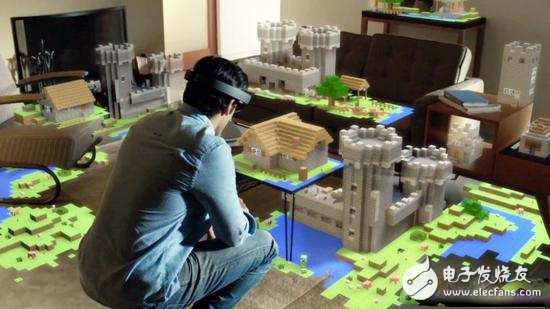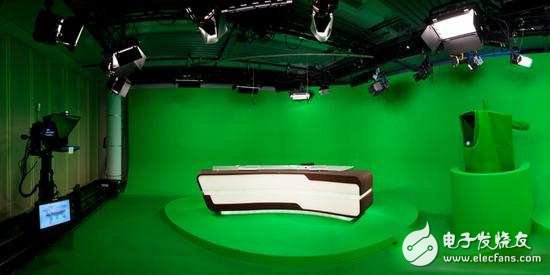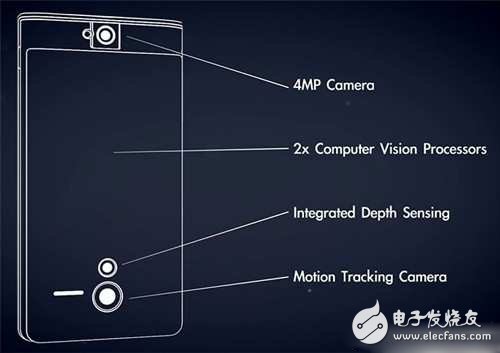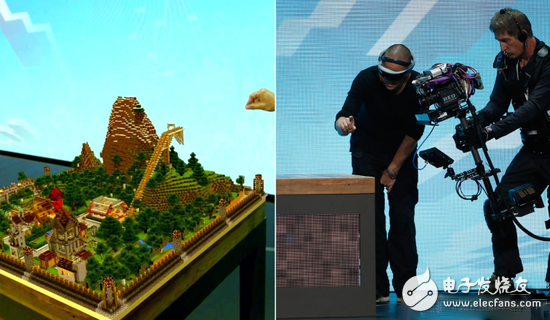
With the evolution of virtual reality technology, there are now more and more scenes we can see the emergence of virtual reality technology. The TV industry is one of them: last year's World Cup, this year's Spring Festival Evening we can see the emergence of virtual studios in live programs.
This military parade, we can also see that Beijing TV station also adopted virtual studio technology: the audience can see that the host explained that the virtual weaponry will appear next to him, vividly showing the military equipment to the audience. The mighty majestic, not the dry text or picture description.

Virtual studio technology can actually be said to be a subset of augmented reality technology. It also involves the question of how to overlay virtual elements with real scenes in augmented reality. However, augmented reality is to have the final picture appear in the user's eyes, while the virtual studio presents the picture on the screen of the TV.
Therefore, its technical focus is the same as augmented reality:
The first is how to accurately locate the real scene;
The second is how to render virtual elements;
The third is how to superimpose the virtual elements on the real scene in real time and then return to the video stream.
The hardest part here is how to overlay virtual elements with real elements.
Once the camera is moving, the real scene and the virtual elements must match this movement. The frame rate of TV camera is 50FPS, which means that the engine needs to render one frame every 20ms, which is a very high requirement. Therefore, the system should include the working state of the camera, including the position and angle of view, etc., and the virtual engine can render the corresponding picture.

(virtual studio) (virtual studio)
So, here you can get a virtual studio system flow:
The first step is to collect the camera's working status information, the most important is the camera's position and its relative relationship with the real scene; then transfer this information to the graphics workstation.
The second step is to obtain the distance and relative position between the foreground object and the camera, thereby calculating the size and position of the virtual element, and rendering and generating the virtual element.
If the virtual element involves a virtual character (such as a virtual player in a World Cup show, or a Yang Yang in the spring evening), it often involves a motion capture system: the action of the virtual character is driven in real time by the action of the real person, and then presented.
In the third step, the virtual studio system integrates the host's real-time image with the computer-generated virtual elements to form a scene that does not exist in reality, and broadcasts to the audience in real time.
In general, the green screen we use in movie trailers will cover all the scene elements we don't want it to appear in the final picture. In the profession, this is called "color key". Then the computer will remove all the corresponding colors, gather the virtual scenes, and finally show what we will see in the parade live broadcast. The mighty missile launcher appears next to the host.
Virtual studios can be said to be a commercial application of augmented reality technology, and have been able to mature in commercial live broadcasts.
But augmented reality itself has a long way to go – because augmented reality glasses in the consumer sense have to solve many of the difficulties that virtual studios don't have:
First, the virtual studio will be applied in a controlled scene.
There are special equipment to capture the position of the camera and the location of the scene itself, while the augmented reality glasses need to be applied in a wide range, which requires the very hot technical field of computer vision SLAM (Simultaneously LocalizaTIon And Mapping, real-time scene measurement and construction) Mold) to help augmented reality glasses "see" and "understand" the surrounding environment. Google's Project Tango is a project developed to solve this problem.

(Google's Project Tango project)
Second, mobile VR glasses may have much less computing power than commercial-grade workstations in virtual studio technology.
Therefore, its ability to render virtual elements at high frame rates is far less than that of virtual studios. The virtual images of augmented reality glasses are not as rich and realistic as virtual studios.
The third point is that the picture of the augmented reality glasses is ultimately projected into the user's retina.
Therefore, in order to meet the characteristics of the human body's visual system, the ability of the display device to be different from the ordinary screen: people feel the fusion of virtual and reality, the display needs to match the focus of the human eye to display the ability of virtual elements, currently Only Microsoft's HoloLens convincingly demonstrated this ability, and they used a holographic display.
What's interesting is that at this year's E3 Microsoft conference, Microsoft used virtual studio technology to showcase what HoloLens can achieve in the end - perhaps the best effect that virtual studios can achieve at this conference. Microsoft also used sophisticated camera tracking technology to convincing the audience to showcase HoloLens' augmented reality.

(Microsoft's HoloLens)
So, what is the military parade in the future augmented reality? In accordance with established practice, the next big military parade in China will be held in 2019. I think that the parade will have augmented reality participation at the time - the audience will be able to use their own augmented reality glasses in real time, or see the mighty and mighty troops on the screen, accompanied by an introduction to their weapons and equipment, details are magnified Even dismantling... We will see that the parade will not be limited to the only two poses in the field or in front of the TV, but it may be able to use virtual reality. The evolution of technology is waiting to be seen.
First, Wireless Router
So what is a wireless router?
Wireless router, according to the definition of Baidu Encyclopedia: Wireless router is used for users to access the Internet, with wireless coverage of the router.
A wireless router can be thought of as a repeater that forwards the broadband network signal from the wall of your home through an antenna to nearby wireless network devices (laptops, Wifi-enabled phones, tablets, and all Wifi-enabled devices).
The popular wireless routers in the market generally support four access methods: dedicated xdsl/cable, dynamic xdsl, pptp, and generally can only support 15 to 20 devices online at the same time. It also has some other network management functions, such as dhcp service, nat firewall, mac address filtering, dynamic domain name and so on. The signal range of the general wireless router is 50 meters radius, and the signal range of some wireless routers has reached 300 meters radius.
The name of wireless router can be separated out of two keywords: wireless and routing.
Understand the technical principle behind these two words, you understand the wireless router.
Wireless is also what we often call Wi-Fi. Wireless routers can convert home broadband from wired to wireless signals, and all devices can happily surf the Internet as long as they connect to their own Wi-Fi. In addition, these devices also form a wireless local area network, where local data is exchanged at high speed and is not limited by the bandwidth of home broadband.
For example, many people have smart speakers in their homes that can be used to control various smart appliances. When you say small X small X, turn on the TV, the speaker actually finds the TV through the LAN and sends instructions, and does not need to connect to the Internet; And if you let it broadcast news, you have to get data through the Internet.
The Local Area Network we talked about earlier, also known as the Intranet, is represented by the Local Area Network (LAN) on the router, so the Wi-Fi signal is also called WLAN(Wireless LAN); The Internet we want to access, also known as the extranet, is represented on the router by the WAN(Wide Area Network).
On the Intranet, the IP address of each device is different, which is called a private address. All devices on the Internet share the same public address, which is assigned by broadband operators such as China Telecom Unicom.
The router is the bridge between the Intranet and the external network. The above mentioned IP address translation, packet forwarding, is the router routing function. In other words, the router is the hub of the home network, and the data of all the devices must be forwarded through it to access each other or reach the external network, which means that one husband is the key and ten thousand men are not open, so the comprehensive router is also called "home gateway".
Second, the demand for wireless routers
I do not know if there is a sudden WIFI break when you play games at home, and a stable router is crucial at this time. However, it is important to note that your WIFI frequently dropped may not be a problem with the router, it may also be a problem with the carrier network. (Router means I don't back this pot)
In fact, for most people, there are two basic requirements for wireless routers
Stable and do not drop
Fast Internet and easy setup
Some people will have some advanced needs:
There are some features, USB interface, can be external U disk or hard disk, can achieve simple nas functions, QOS, etc., to advertising and so on
Mesh networking, when the house area is large, multiple routers can be used for Mesh networking
How to choose a wireless router
The wireless router market is in the transition stage from WiFi 5 to WiFi 6, if you want to buy the first choice is definitely WiFi 6 wireless router, which is the future trend.
The speed of WiFi 6 is nearly 40% higher than the previous generation 802.11ac, and the highest connection speed can even reach 9.6Gbps, while the highest speed of 802.11ac is only 6.93Gbp. More importantly, unlike 802.11ac, which only covers the 5GHz band, WiFi 6 covers 2.4GHz and 5GHz. Although the 5GHz band has less interference, it has weak wall penetration ability, and the 2.4GHz band has strong wall penetration ability, which takes into account each other.
So why choose a WIFI6 router?
Compared with the previous generation of 802.11ac WiFi 5, the maximum transmission rate of WiFi 6 in the 5Ghz band has been increased from 3.5Gbps to 9.6Gbps, and the theoretical speed has been increased by nearly 3 times. WiFi 6's 5Ghz single-stream 80Mhz bandwidth can reach theoretical speeds of up to 1201Mbps and 160Mhz bandwidth of up to 2402Mbps.
The band supports 2.4Ghz and 5Ghz.
In terms of modulation mode, WiFi6 supports 1024-QAM, which is higher than the 256-QAM of WiFi 5, and the data capacity is higher. Some high-end WiFi 6 routers support 4096-QAM.
WiFi6 supports MU-MIMO (multi-user multiple-input multiple-output) technology, and supports both upstream and downstream MU-MIMO, with a maximum support of 8T×8R MU-MIMO. The speed is greatly improved. High concurrency, WiFi6 5GHz band, terminal connections up to 128! 5 times that of WiFi5. Effectively solve the Internet needs of multi-person networking and smart home;
WiFi6 adopts OFDMA (orthogonal frequency division multiple access) technology. After using OFDM to parent the channel, the transmission technology of transmitting data is loaded on the subcarrier, allowing different users to share the same channel, allowing more devices to access, with shorter response time and lower delay.
Low latency, WiFi6 time delay can be as low as 10ms, compared to WiFi5 30ms delay, only 1/3. This performance refresh is extremely friendly to game lovers;
If WiFi6 (wireless router) devices need to be certified by the WiFi Alliance, they must use the WPA 3 security protocol, which is more secure.
The WiFi6 wireless router is backward compatible with WiFi5 and WiFi4 terminals.
Fourth, the misunderstanding of purchasing routers
Is the through-wall router really through-wall?
Mistake; The country has strict limits on the transmission power of the wireless router antenna, if you have a lot of rooms in your home, and there are many walls between them, even if you buy an expensive wireless router, you can not do one to cover all the room signals. If the signal is not good, you can consider multiple wireless router Mesh networking.
Does a wireless router have a stronger signal with more antennas?
More antennas just to match the X*X MIMO mode, the more antennas, the more channels, can only ensure that the network is more stable, the impact on the signal is little, the strength of the signal is only related to the wireless transmission power. The wireless transmission power of the country has a standard.
Wifi 5 Wireless Router,5Gz Wifi Router,Wi-Fi Routers For The Home,Lte Modem Router
Shenzhen MovingComm Technology Co., Ltd. , https://www.szmovingcomm.com
